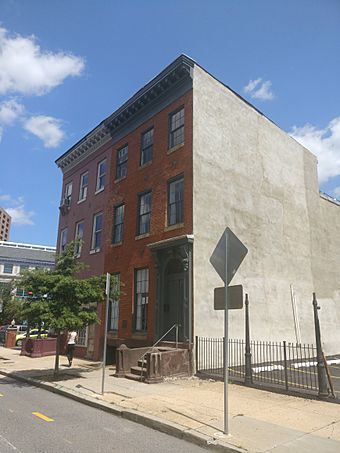Henry August Rowland House facts for kids
|
Henry August Rowland House
|
|
 |
|
| Location | 915 Cathedral St., Baltimore, Maryland |
|---|---|
| Built | c. 1885 |
| NRHP reference No. | 75002098 |
Quick facts for kids Significant dates |
|
| Added to NRHP | May 15, 1975 |
| Designated NHL | May 15, 1975 |
The Henry August Rowland House is a special historic building in Baltimore, Maryland. It's a type of home called a row house, built around the 1880s. This house is important because it was the home of a famous scientist named Henry Augustus Rowland. He lived here from about 1889 until he passed away in 1901.
In 1975, the house was recognized as a National Historic Landmark. This means it's a very important place in American history. It's also listed on the National Register of Historic Places.
Contents
What Does the Rowland House Look Like?
The Henry August Rowland House is in a part of Baltimore called Mount Vernon. You can find it on the corner of Cathedral and Brexton Streets. It's one of two similar homes built close together.
This house is three stories tall. It's made of red brick, which was common for homes in the 1880s. The roof is flat and has a fancy carved wooden edge. The front of the house has three sections, and the main door is on the right. It has a special design around it with a small roof over the top.
Inside, the house was in good shape back in 1975. It still had some of its original features. One cool thing was a working dumbwaiter, which is like a small elevator for moving food or other items between floors.
Who Was Henry Augustus Rowland?
Henry Augustus Rowland was a brilliant American physicist. A physicist is a scientist who studies how the world works, like energy, forces, and matter. Rowland was born in 1846.
He bought this house in Baltimore around 1889 or 1890. He lived there until he died in 1901. After he passed away, his wife and daughter continued to live in the house.
Rowland's Education and Early Career
Henry Rowland studied physics at Rensselaer Polytechnic Institute in New York. He also continued his studies in Germany. In 1876, he was invited to join Johns Hopkins University in Baltimore. Daniel Coit Gilman, who was the first president of the university, hired Rowland. His job was to help build the university's physics department.
What Were Rowland's Key Discoveries?
Henry Rowland made many important contributions to science. He helped us understand magnetism better and developed new tools for studying it. He also created a formula that showed how heat could be turned into mechanical work.
One of his most famous inventions was the high-precision diffraction grating. This special tool helps scientists analyze light and see its different colors. It was a very important invention for studying the properties of light and materials.
A famous science writer, Isaac Asimov, once said that Rowland was "one of the few important 19th century American physicists." This shows how much his work was valued.
Images for kids





